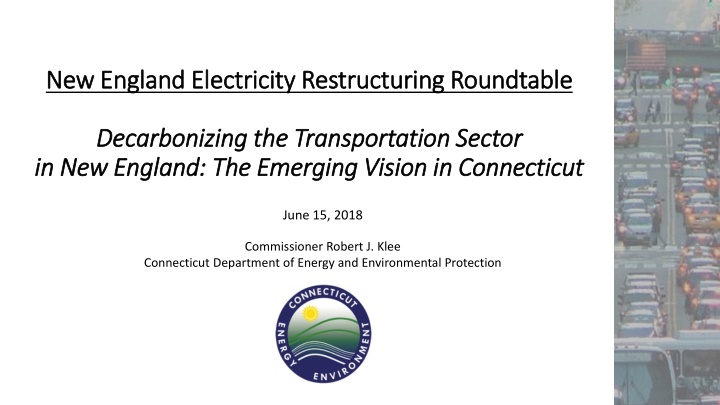
Decarbonizing Transportation Sector in Connecticut: Vision & Initiatives
Explore Connecticut's drive towards decarbonizing the transportation sector through initiatives like the CHEAPR program, critical infrastructure investments, and sustainable energy deployment. Learn about the state's ambitious goals in reducing GHG emissions and promoting clean transportation technologies.
Download Presentation

Please find below an Image/Link to download the presentation.
The content on the website is provided AS IS for your information and personal use only. It may not be sold, licensed, or shared on other websites without obtaining consent from the author. If you encounter any issues during the download, it is possible that the publisher has removed the file from their server.
You are allowed to download the files provided on this website for personal or commercial use, subject to the condition that they are used lawfully. All files are the property of their respective owners.
The content on the website is provided AS IS for your information and personal use only. It may not be sold, licensed, or shared on other websites without obtaining consent from the author.
E N D
Presentation Transcript
New England Electricity Restructuring Roundtable New England Electricity Restructuring Roundtable Decarbonizing the Transportation Sector Decarbonizing the Transportation Sector in New England: The Emerging Vision in Connecticut in New England: The Emerging Vision in Connecticut June 15, 2018 Commissioner Robert J. Klee Connecticut Department of Energy and Environmental Protection
New England Electricity Restructuring Roundtable June 15, 2018 Commissioner Robert J. Klee Connecticut Department of Energy and Environmental Protection
Connecticut Still Revolutionary Connecticut Still Revolutionary Governor s Council on Climate Change (GC3) Establish interim GHG targets & plan to achieve them Connecticut Green Bank Deploy clean energy at scale Public Act 18-82 (Senate Bill 7) Planning for up to 20 in./50 cm of sea level rise by 2050 Interim target of 45% reduction in economy-wide GHG emissions below 2001 levels Public Act 18-50 (Senate Bill 9) 40% RPS by 2030 Statewide shared clean energy program Sustainable deployment of behind-the-meter resources for residential & commercial/industrial
Connecticut Hydrogen and Electric Automobile Connecticut Hydrogen and Electric Automobile Purchase Rebate Program (CHEAPR) Purchase Rebate Program (CHEAPR) On the hood incentives to drive down costs of BEV, FCEV and PHEV Incentive Amount EPA Rated Electric Range $5,000 Any fuel cell electric vehicle $3,000 BEV: 175 Miles or Greater BEV: 100-174 Miles PHEV: 40 Miles or Greater $2,000 BEV: Less 100 Miles PHEV: Less than 40 Miles $500
Critical clean transportation infrastructure Critical clean transportation infrastructure investments in Connecticut investments in Connecticut New transit CT Fastrak (New Britain to Hartford) CT Rail Hartford Line (New Haven-Hartford-Springfield) H2Fuels Program Up to $840,000 to develop and operate a retail hydrogen fueling station in the greater New Haven area. VW Settlement Recently announced Round 1 $7.5M of CT s ~$54M Eligible projects must reduce nitrogen oxide (NOx) emissions across the state
Collaboration with other states Collaboration with other states California & the 12 Section 177 States Active participation in CARB proceedings Pushing back against federal rollbacks OP-ED: We Won t Abide Selective State Rights 8-State ZEV MOU Updated action plan coming soon
Transportation & Climate Initiative (TCI) Transportation & Climate Initiative (TCI) Modernize the transportation system to reduce congestion and improve reliability and resiliency. Reduce carbon emissions and other harmful pollutants. Enhance the economic competitiveness of states in the Northeast on a national and global scale.
Transportation is the largest source of Transportation is the largest source of carbon pollution in the region carbon pollution in the region 2015 EIA Data
GHG Emissions Future Projections LEAP Projections by Sector, Reference Case 50 45 40 2050 GHG Share 2050 GHG Share 35 Industrial Processes 6% Industrial Processes 6% 30 MMTCO2e Waste 7% Waste 7% Industrial 10% Industrial 10% 25 C & I 12% C & I 12% 20 Electric Power 13% Electric Power 13% 15 Residential Residential 15% 15% 10 Transportation 35% Transportation 35% 5 0 2010 2015 2020 2025 2030 2035 2040 2045 2050 *The agriculture and non-energy sectors represent 1% and 0.3%, respectively, of total emissions in 2050.
Why modernize our transportation system? Why modernize our transportation system? Prosperity New markets and technologies Leverage our strong workforce, universities & advanced research centers Efficiency Operations and productivity Connectivity to jobs, education, services, markets Customer-focused Health Improves air quality Avoids asthma, other respiratory illnesses and cardiovascular conditions Decreases work days lost and provides savings in healthcare costs Vibrant communities Complete streets Smart growth Connectivity and access
Possible goals for a low carbon transportation Possible goals for a low carbon transportation policy policy Provide incentives for people, companies and governments to choose cleaner transportation options Encourage investments by the private sector in clean technology innovation and market development Create a price signal so that market prices for transportation reflect damages caused by carbon pollution Raise funds for states to invest in more reliable, cleaner and resilient transportation systems
Examples of actions identified by Examples of actions identified by stakeholders to date stakeholders to date Congestion pricing - cost to enter specific areas at high-traffic times Vehicle-miles-traveled fees - cost based on miles driven instead of fuel consumed Rebates - for use of public transit or purchase of zero-emission options Electrification zone - a requirement that all vehicles be electric to enter a certain city zone or use a certain travel corridor Cap-and-invest system - a pollution cap that levies a cost on fuel suppliers to generate revenue for investment EV-ready codes - building codes requiring new construction to have a certain quantity of installed EV charging Green Bank - public funding to support private investments in new technologies and services
On the need for bolder action On the need for bolder action without bolder action, our children won t have time to debate the existence of climate change; they ll be busy dealing with its effects: environmental disasters, economic disruptions, and waves of climate refugees seeking sanctuary. Now, we can and should argue about the best approach to the problem. But to simply deny the problem not only betrays future generations; it betrays the essential spirit of innovation and practical problem-solving that guided our Founders. President Barack Obama




















